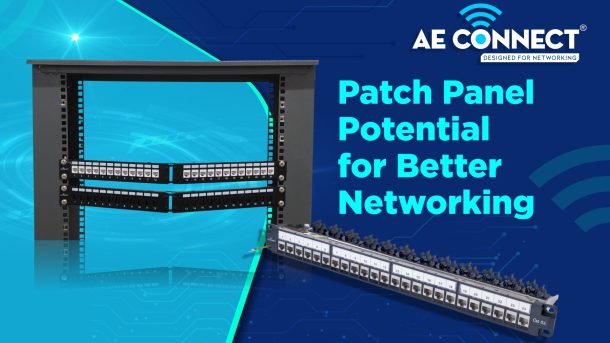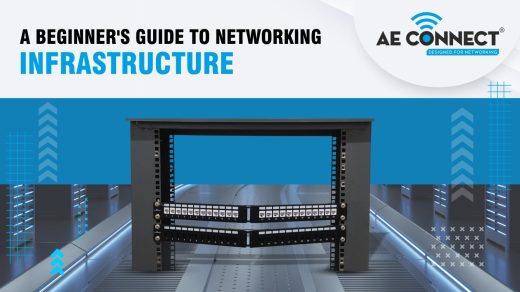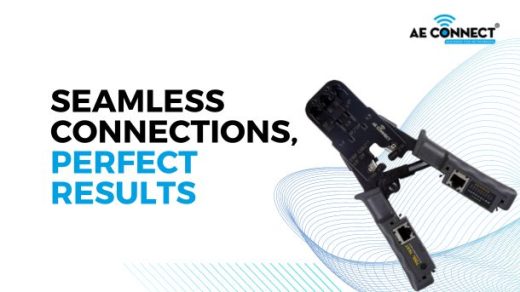In today’s fast-paced, data-driven world, a robust and dependable network infrastructure plays a pivotal role in the success of businesses and organizations.
Whether you operate a small home office or a sprawling data centre, the efficiency of your network can determine your achievements.
Among the various tools and components for effective network management, the patch panel emerges as a foundational and often underestimated asset.
What is a Patch Panel?
A patch panel is a piece of hardware used in networks to arrange and connect various connections. It is a flat, rectangular board with several ports on it.
Each port is linked to a particular cable, which is subsequently routed to the relevant network devices.
There are various patch panel networking applications, including
- Local Area Networks (LANs)
- Wide Area Networks (WANs)
- Telecommunications Networks
- Data Centres
These panels can be mounted in two primary ways
Rack-mounted: Installed within a metal frame (rack) that houses networking equipment, ensuring accessibility and streamlined management.
Wall-mounted: An alternative, though less common, mounting option.
Elevating Network Efficiency: 5 Ways Patch Panels Make a Difference
A well-implemented patch panel offers several advantages that significantly enhance your network’s performance and maintenance.
Improved Cable Management
A patch panel allows you to neatly organize your network cables in a single location. This facilitates the detection of cable issues and their resolution while also assisting in the preservation of cables.
Simplified Troubleshooting
Finding the cause of network issues is made simple with a patch panel. If a device isn’t functioning properly, you can easily determine which port is connected to it by following the cable back to the patch panel.
When attempting to troubleshoot network issues, this can save you a tonne of time and frustration.
Increased Performance
A network patch panel can help to improve the performance of your network by reducing the amount of signal attenuation. This is because patch panels use short patch cables, which have less attenuation than long cable runs.
Reduced Clutter
A patch panel can help to reduce the clutter of cables in your network closet or server room. This makes it easier to find and access the devices you need, and it also helps to improve the airflow in your network closet.
Seamless Scalability
It is simple to add new devices to your network with a patch panel.
Just plug in the new device’s cable to the patch panel, then set up the switch or router to connect to it. Without having to re-run any cords, this may be completed fast and easily.
Choosing the Perfect Patch Panel for Your Network
Optimising the performance of your network requires choosing the appropriate patch panel. Here are some crucial elements to take into account when choosing
Port Density
Determine the number of ports you need based on your current requirements and future growth projections. Opt for a patch panel that can accommodate additional ports for future expansion.
Cable Compatibility
Ensure that the network patch panel is compatible with the type of cables you are using. Different patch panels are designed for specific cable categories, such as Cat6, Cat6a.
Rack Mount or Wall Mount
Decide whether you need a rack-mounted patch panel or a wall-mounted patch panel, depending on the available space and layout of your network room.
Ease of Maintenance
Look for a patch panel with clear labelling and easy-to-access ports. This will simplify troubleshooting and maintenance, saving time and effort in the long run.
Brand Reputation and Warranty
Opt for reputable brands like AE Connect, known for producing high-quality patch panels. Check the warranty terms to ensure you are protected in case of any defects.
The 7 Most Common Patch Panel Mistakes to Avoid
Unknowingly we make mistakes if we don’t have real knowledge of patch panels. Here are some common patch panel mistakes to avoid.
Incorrect Cable Termination
Improperly terminated cables can lead to signal loss and network disruptions. Take the time to follow the correct termination procedures or seek professional assistance.
Neglecting Cable Management
Poor cable management can lead to a mess of tangled wires, making maintenance and troubleshooting a nightmare. Implement proper cable management techniques from the start.
Skipping Labeling
Failing to label cables and ports can lead to confusion and delays during maintenance. Always label both ends of the cable and corresponding ports on the patch panel.
Overloading Ports
Overloading ports with excessive connections can strain the patch panel and cause connectivity issues. Plan your port usage carefully to avoid overloading.
Inadequate Testing
Skipping testing after installation can lead to undetected faults and poor network performance. Thoroughly test all connections to ensure everything is working correctly.
Ignoring Environmental Factors
Placing the patch panel in an unsuitable environment, such as one with excessive heat or moisture, can lead to premature failure. Ensure proper ventilation and temperature control.
Lack of Documentation
Neglecting to maintain detailed documentation of the network and patch panel layout can create confusion during maintenance and upgrades. Keep records of all connections and changes.
How to Install a Patch Panel?
1. Gather tools: patch panel, punch-down tool, wire strippers, cable tester, and cable ties.
2. Choose a mounting location that’s central and easily accessible.
3. Mount the patch panel using provided screws.
4. Strip the outer jacket of cables and strip insulation from individual wires.
5. Identify the correct colour wires for each port based on colour coding schemes.
6. Insert wires into the patch panel’s punch-down connectors in proper order.
7. Crimp wires using a punch-down tool, avoiding over-crimping.
8. Test each cable connection using a cable tester.
9. Organize cables by tying them up with cable ties.
AE Connect: Elevating Your Network with Superior Patch Panels
In today’s dynamic business landscape, AE Connect stands as the premier provider of high-quality patch panels tailored to businesses of all sizes.
Our patch panels are constructed with the best quality components and supplies and are built to last for years of service. They are straightforward to install and use, making it simple to set up your network.
Further, it’s a cherry on the cake that – in our patch panels, if one port gets damaged, the user doesn’t require to replace all ports. Just one Keystone can be changed.
AE -PP624
- Cat6 24-port loaded patch panel
- Easy snap-in keystone jacks
- Rear cable management
- Entire steel outer frame with plastic powder cladding
- Comes with individual IO
AE-PP648
- 48 ports loaded patch panel
- Available in 48 ports 1U / 48 ports 2U
- Entire steel outer frame with plastic powder cladding
- Easy snap-in keystone jacks
- Rear cable management
AE-PPAC6UTP
- Cat6 24 ports UTP angular patch panel
- Blank slot to fit data keystone
- Easy port labelling identification provision
- Back bar support for convenient cable management
- Standard 19′′ rackmount (1U)
- Comes with individual IO
AE-CAT6APP-SFTP
- Supports 10G Base-T
- No punch-down tool is required
- 19′′ rack-mounted patch panel
- 24 ports in 1RU space
- Rear cable management
- Shielded toolless keystone jacks
- Gold-plated connection pins
- Zinc coating to prevent earthing and corrosion
Conclusion
Patch panels are a critical component for building a scalable and reliable network infrastructure. They offer several benefits, and to optimize their impact, one must choose the right patch panel, avoid common mistakes, and install them correctly.
AE Connect provides top-quality patch panels that cater to various business sizes and needs. By leveraging these efficient solutions, businesses can ensure seamless data flow and successful operations in today’s technologically advanced world.








